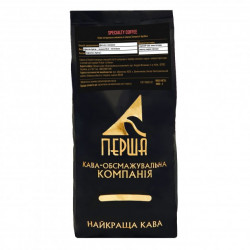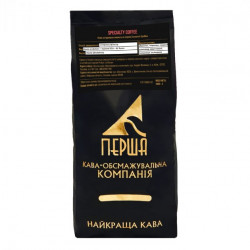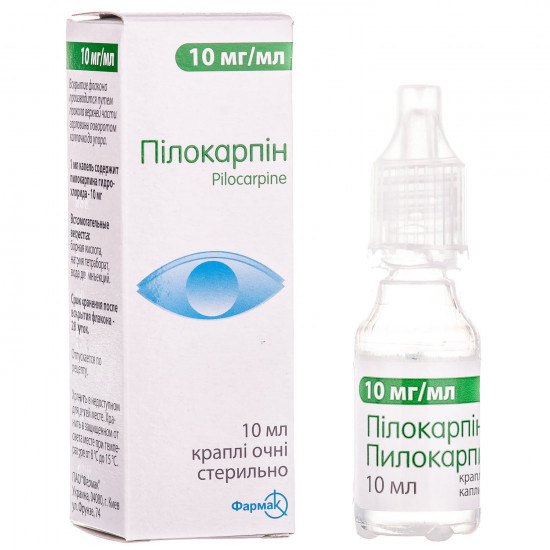
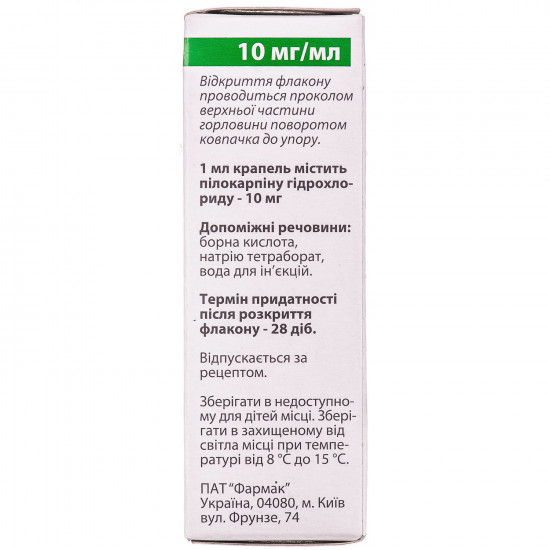
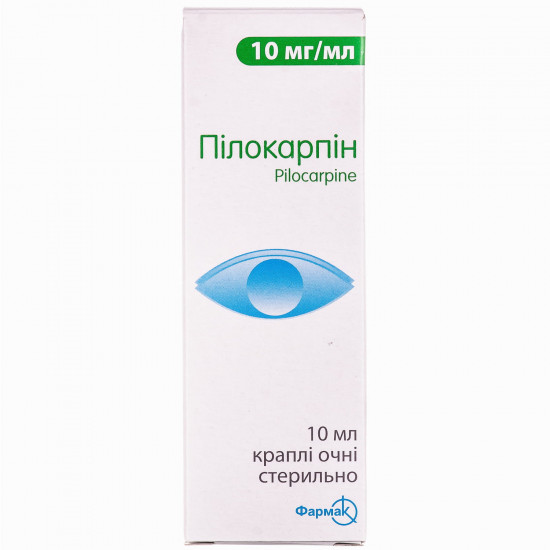
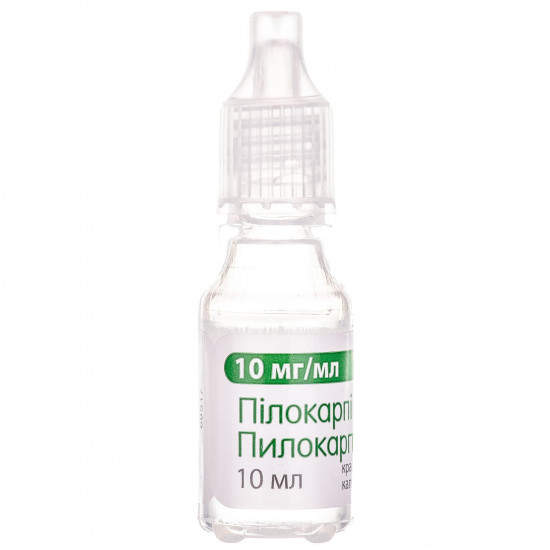




- Stock: In Stock
- Model: 179712
0% Customers recommend this product
-
5 Awesome0%
-
4 Great0%
-
3 Average0%
-
2 Bad0%
-
1 Poor0%
Reviews Over Pilocarpine cap. eye. 10mg/ml fl. 10 ml
- (0)
Total Reviews (0)
click here write review to add review for this product.
Report this review.
Description
Pharmacological properties
Pharmacodynamics. pilocarpine the hydrochloride belongs to m - cholinomimetic means. the mechanism of action is caused by excitement of peripheral m-holinoretseptorov that causes reduction of a circular muscle of an iris and tsiliarny muscle, is followed by narrowing of a pupil and opening of a corner of an anterior chamber of an eye, improvement of outflow of intraocular liquid that in general causes decrease in intraocular pressure and improves trophic processes in eye tissues. decrease in intraocular tension reaches 3–4 mm Hg.
Pharmacokinetics. At instillation on a pilocarpine conjunctiva the hydrochloride gets through a cornea and as much as possible concentrates in watery moisture of an eye in 30–40 min. T ½ from an eye — 1.5-2 h, nevertheless effect of medicine on the level of intraocular pressure continues during 4–8 h. Pilocarpine the hydrochloride is not metabolized in eye tissues, and removed together with intraocular liquid, inactivated by hydrolysis in blood serum and a liver. T ½ from blood plasma — 30 min.
Indication
Primary and chronic open angle glaucoma. bad attack of closed-angle glaucoma. chronic closed-angle glaucoma (before surgical intervention). secondary glaucoma (as a result of thrombosis of the central vein of a retina, sharp impassability of an artery of a retina, an atrophy of an optic nerve, a pigmentary degeneration of a retina, a vitreous hemorrhage). need of narrowing of a pupil at overdose of a midriatikama, with the diagnostic purpose and during surgical interventions (except persons with shortsightedness of high degree).
Use
Pilocarpine are dug in in each eye on 1–2 drop by 2–4 times a day. the daily dose and duration of a course of treatment is defined by the doctor depending on the level of intraocular pressure. if necessary medicine can be combined with blockers of β-adrenoceptors.
At a bad attack of closed-angle glaucoma Pilocarpine is appointed: for the first hour — each 15 min. on 1 drop; for 2–3 h — each 30 min. on 1 drop; for 4–6 h — each 60 min. on 1 drop; further — 3–6 times a day before knocking over of an attack.
Contraindication
Iritis, an iridocyclitis, iridotsiklichesky crisis, a uveitis, a cyclitis, a keratitis and other diseases of an eye at which narrowing of a pupil is undesirable (after surgical interventions on an eye for prevention of emergence of back synechias). paradoxical reaction to medicine at a stagnant form of glaucoma.
Pilocarpine should be applied at patients with peeling of a retina in the anamnesis, persons of young age with shortsightedness of high degree. Acute inflammatory diseases of tissues of eye. Allergic reactions to components of medicine and bronchial asthma in the anamnesis.
Side effects
during use of pilocarpine can develop:
- local by-effects: a miosis, short-term eye pain, hyperaemia, an accommodation spasm as a consequence of a persistent miosis (during the night period of day), decrease in visual acuity, a headache in temples and paraorbital areas, the strengthened dacryagogue, allergic conjunctivitis and dermatitis of an eyelid skin, a superficial keratitis, an itch in eyes, shortsightedness, photophobia, conjunctiva hyperaemia, hypostasis and an erosion of a cornea, a spasm of a tsiliarny muscle; occasionally — peeling of a retina;
- system by-effects develop very seldom: a bronchospasm, a headache, dizziness, hypersalivation, a rhinorrhea, a fluid lungs, increase in the ABP, bradycardia, vascular disorders, arterial hypotension, the increased perspiration, nausea, vomiting, diarrhea; long-term treatment can lead
- to follicular conjunctivitis, contact dermatitis a century, to a keratopathy, a cataract, a reversible cataract, changes of conjunctival fabric.
Special instructions
Just before application should take a bottle with medicine in a palm to warm up to body temperature. the lid is unscrewed, removed and, slightly pressing on the bottle body, dig in solution in an eye. after burying the lid is densely screwed up.
to applyWith care to the patients with an acute heart failure who are recently postponed a myocardial infarction, heavy bradycardia, arterial hypotension, AG, a hyperthyroidism, epilepsy, obstruction of uric ways, vasomotorial instability, Parkinson's disease.
Miotic medicaments are used at absence in an iris of neogenic vessels.
Increase in concentration and frequency of instillation (≥6) — is inexpedientbecause it does not lead to strengthening of hypotensive effect and causes the general negative reactions of an organism.
Pilocarpine practically does not influence intraocular tension level at healthy people, but is effective at patients with glaucoma of different forms. It is desirable throughout for about 1-3 years of month Pilocarpine to replace with other, not miotic medicines. At long burying the miosis remains all the time that important for people of advanced age with a phacosclerosis and a cataract of an initial stage.
Use during pregnancy and feeding by a breast. Use during pregnancy and feeding by a breast perhaps only in case, according to the doctor, the expected effect exceeds risk of possible side reactions.
Children. Drug is not used at children.
Ability to influence speed of response at control of vehicles or work with other mechanisms. At use of medicine the driving of vehicles and occupation is not recommended by other potentially dangerous types of activity demanding sight clearness.
Interaction
Atropin and other m - cholinolytic medicines are antagonists of pilocarpine. at simultaneous application with adrenostimulyator the antagonism of action (influence on diameter of a pupil) can be noted.
Timololum and a phenylephine hydrochloride strengthen decrease in intraocular pressure.
use of Pilocarpine in a combination with blockers of β-adrenoceptors, karboangidraza inhibitors Is possible.
M-holinostimuliruyushchee effect of Pilocarpine decreases at a combination with the tricyclic antidepressants derivative of a fenotiazin, chlorprothixene, clozapine; amplifies antikholinesterazny medicines.
developing of bradycardia and decrease in the ABP Is possibleduring the general anesthesia using Ftorotanum (at the patients applying Pilocarpine in the form of eye drops).
Overdose
First symptoms of overdose — nausea, bradycardia, can develop a persistent miosis, eye pain, a disorder of vision, a headache. with the advent of these symptoms, medicine is cancelled. treatment at overdose symptomatic. atropine, tropikamid it is possible to apply as specific antidotes. at the expressed bradycardia because of overdose of parasympathomimetics enter 0.5-2 mg of atropine parenterally.
Storage conditions
B the place protected from light at a temperature of 8-15 °C.
Specifications
| Characteristics | |
| Active ingredients | Pilocarpine |
| Amount of active ingredient | 10 mg/ml |
| Applicant | Pharmak |
| Code of automatic telephone exchange | S01EB01 Pilocarpine |
| Interaction with food | It doesn't matter |
| Light sensitivity | Sensitive |
| Market status | Generic-generic |
| Origin | Vegetable |
| Prescription status | According to the prescription |
| Primary packing | bottle |
| Producer | PUBLIC JOINT STOCK COMPANY PHARMAK |
| Quantity in packing | 10 ml |
| Release form | eye drops |
| Route of administration | Eye |
| Sign | Domestic |
| Storage temperature | from 8 °C to 15 °C |
| Trade name | Pilocarpine |










